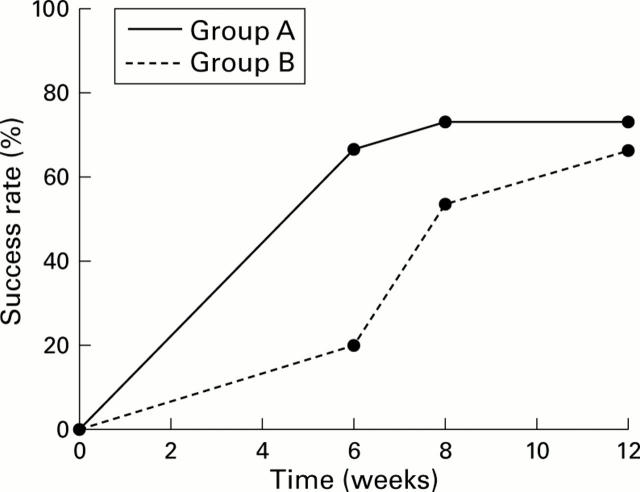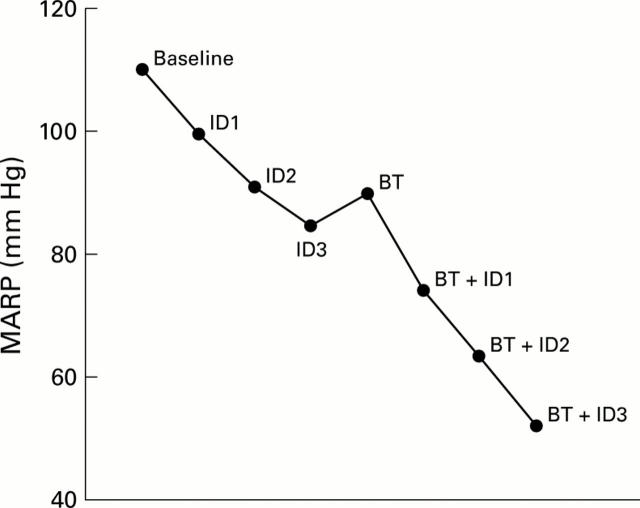Abstract
BACKGROUND—Anal fissure is perpetuated by high sphincter pressures and secondary local ischaemia. Pharmacological approaches include topical nitrates and botulinum toxin (BT) which act to reduce anal pressure. BT lowers anal pressure by preventing acetylcholine release from nerve terminals while topical nitrates act by donating nitric oxide (NO). The aims of the present study were to compare the therapeutic effect and lowering action on internal anal sphincter pressure of BT injection and local application of isosorbide dinitrate (ID) compared with BT given alone, in patients with chronic anal fissure (CAF) refractory to treatment with ID. METHODS—Thirty consecutive patients with CAF who did not respond to previous topical ID treatments were randomly assigned to receive one of the following treatments: group A, injection of BT (20 U into the internal anal sphincter) and subsequent daily applications of ID (2.5 mg three times daily for three months); and group B, BT injection only (20 U). If at the end of six weeks following BT injection no improvement was seen in group B, ID was added. A series of anal pressure measurements, including resting basal pressure and resting pressure following topical ID (1.25, 2.5, and 3.75 mg), was carried out both before and two weeks after 20 U of BT injection into the internal anal sphincter. At the end of the trial, patients were followed up for an average period of 10 months. FINDINGS—At six weeks the fissure healing rate was significantly higher in group A patients (10/15 (66%)) compared with group B (3/15 (20%)) (p=0.025). At eight and 12 weeks, no significant differences were seen: 11/15 (73%) v 11/15 (73%) and 9/15 (60%) v 10/15 (66%), group A v group B, respectively. Maximum anal resting pressure (MARP) was significantly lower two weeks after BT injection than baseline MARP (90 (4) v 110 (5) mm Hg; p<0.001). A significantly greater reduction in MARP following local application of ID was achieved after BT injection compared with that achieved before BT injection (p=0.037) INTERPRETATION—(1) Combined BT injection and local application of ID in patients with CAF who failed previous treatment with ID was more effective than BT alone. This treatment modality appears to be safe and promising. (2) ID application induced a greater reduction in MARP following BT injection compared with ID application before BT injection. The improved potency of ID on MARP after BT injection suggests a primary cholinergic tonus dominance in some patients and not, as previously claimed, anal sphincter insensitivity to nitrates. Keywords: nitrates; botulinum toxin; anal fissure
Full Text
The Full Text of this article is available as a PDF (98.0 KB).
Figure 1 .
Progress of healing in groups A and B.
Figure 2 .
Decrease in maximum anal resting pressure (MARP) by isosorbide dinitrate (ID) and botulinum toxin (BT) in refractory anal fissure patients. Baseline shows mean internal anal sphincter (IAS) pressure in all fissure patients in the study before treatment. ID1, ID2, and ID3 indicate decreases in IAS pressures after 1.25, 2.50 and 3.75 mg of ID before any treatment. BT indicates mean IAS pressure in all study patients two weeks after BT injection. ID+BT indicates decrease in pressure with increasing dose of ID two weeks after BT injection.
Selected References
These references are in PubMed. This may not be the complete list of references from this article.
- Brisinda G., Maria G., Bentivoglio A. R., Cassetta E., Gui D., Albanese A. A comparison of injections of botulinum toxin and topical nitroglycerin ointment for the treatment of chronic anal fissure. N Engl J Med. 1999 Jul 8;341(2):65–69. doi: 10.1056/NEJM199907083410201. [DOI] [PubMed] [Google Scholar]
- Chakder S., Rattan S. Release of nitric oxide by activation of nonadrenergic noncholinergic neurons of internal anal sphincter. Am J Physiol. 1993 Jan;264(1 Pt 1):G7–12. doi: 10.1152/ajpgi.1993.264.1.G7. [DOI] [PubMed] [Google Scholar]
- Chung S. J., Fung H. L. A common enzyme may be responsible for the conversion of organic nitrates to nitric oxide in vascular microsomes. Biochem Biophys Res Commun. 1992 Jun 30;185(3):932–937. doi: 10.1016/0006-291x(92)91716-4. [DOI] [PubMed] [Google Scholar]
- Farouk R., Duthie G. S., MacGregor A. B., Bartolo D. C. Sustained internal sphincter hypertonia in patients with chronic anal fissure. Dis Colon Rectum. 1994 May;37(5):424–429. doi: 10.1007/BF02076185. [DOI] [PubMed] [Google Scholar]
- Fleshman J. W. Anorectal motor physiology and pathophysiology. Surg Clin North Am. 1993 Dec;73(6):1245–1265. doi: 10.1016/s0039-6109(16)46190-6. [DOI] [PubMed] [Google Scholar]
- Gorfine S. R. Treatment of benign anal disease with topical nitroglycerin. Dis Colon Rectum. 1995 May;38(5):453–457. doi: 10.1007/BF02148842. [DOI] [PubMed] [Google Scholar]
- Jost W. H. One hundred cases of anal fissure treated with botulin toxin: early and long-term results. Dis Colon Rectum. 1997 Sep;40(9):1029–1032. doi: 10.1007/BF02050924. [DOI] [PubMed] [Google Scholar]
- Klosterhalfen B., Vogel P., Rixen H., Mittermayer C. Topography of the inferior rectal artery: a possible cause of chronic, primary anal fissure. Dis Colon Rectum. 1989 Jan;32(1):43–52. doi: 10.1007/BF02554725. [DOI] [PubMed] [Google Scholar]
- Loder P. B., Kamm M. A., Nicholls R. J., Phillips R. K. 'Reversible chemical sphincterotomy' by local application of glyceryl trinitrate. Br J Surg. 1994 Sep;81(9):1386–1389. doi: 10.1002/bjs.1800810949. [DOI] [PubMed] [Google Scholar]
- Lund J. N., Armitage N. C., Scholefield J. H. Use of glyceryl trinitrate ointment in the treatment of anal fissure. Br J Surg. 1996 Jun;83(6):776–777. doi: 10.1002/bjs.1800830615. [DOI] [PubMed] [Google Scholar]
- Lysy J., Israelit-Yatzkan Y., Sestiere-Ittah M., Keret D., Goldin E. Treatment of chronic anal fissure with isosorbide dinitrate: long-term results and dose determination. Dis Colon Rectum. 1998 Nov;41(11):1406–1410. doi: 10.1007/BF02237057. [DOI] [PubMed] [Google Scholar]
- Maria G., Cassetta E., Gui D., Brisinda G., Bentivoglio A. R., Albanese A. A comparison of botulinum toxin and saline for the treatment of chronic anal fissure. N Engl J Med. 1998 Jan 22;338(4):217–220. doi: 10.1056/NEJM199801223380402. [DOI] [PubMed] [Google Scholar]
- Schouten W. R., Briel J. W., Auwerda J. J. Relationship between anal pressure and anodermal blood flow. The vascular pathogenesis of anal fissures. Dis Colon Rectum. 1994 Jul;37(7):664–669. doi: 10.1007/BF02054409. [DOI] [PubMed] [Google Scholar]
- Watson S. J., Kamm M. A., Nicholls R. J., Phillips R. K. Topical glyceryl trinitrate in the treatment of chronic anal fissure. Br J Surg. 1996 Jun;83(6):771–775. doi: 10.1002/bjs.1800830614. [DOI] [PubMed] [Google Scholar]




